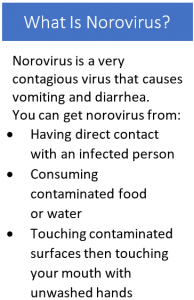When Evacuation is a Must – Protect Yourself from Norovirus
Posted on by
Natural disasters are unpredictable. Often, we don’t know when or where they will happen or if we will have to leave our homes because of them. Evacuations for hurricanes and wildfires can force people into emergency shelters, where close quarters, shared spaces, and high-touch surfaces can make it easy for norovirus to spread.
Norovirus outbreaks occurred in most evacuation shelters in Butte and Glenn counties, Calif., during the Camp Fire in November 2018. Public-health officials identified 292 people ill with acute gastroenteritis caused by norovirus.(1)
A norovirus outbreak among evacuees from Hurricane Katrina in 2005 was also reported in CDC’s Morbidity and Mortality Weekly Report. That outbreak might have affected approximately 1,000 evacuees and relief workers.(2)
What is Norovirus?
Norovirus is a very contagious virus that causes vomiting and diarrhea. Most “stomach bugs” are likely norovirus infections because it’s a relatively common virus. Anyone can catch norovirus from direct contact with an infected person, touching a contaminated surface, or eating contaminated food. It only takes a very small amount of virus particles to make
you sick. The number of particles that could fit on the head of a pin is enough to infect more than 1,000 people.
A person infected with norovirus usually starts to feel ill 12 to 48 hours after they’ve been exposed. The most common symptoms of norovirus infection are diarrhea, vomiting, nausea, and stomach pain. But it can cause fever, headache, and body aches, too.
Be Prepared
Follow the guidance of local officials when going to an emergency shelter during the COVID-19 pandemic. They will tell you when and where to take shelter and what to bring with you.
Act now to prepare “go kits” for family members. Include everyday personal items you cannot do without and other personal protective supplies, such as hand sanitizer with at least 60% alcohol, bar or liquid soap, disinfectant wipes and spray, and at least two masks per person age 2 or older in your household.
If your Emergency Action Plan is to go to a shelter in an evacuation, your kit might also include plenty of nonperishable food and mess kits (e.g., reusable cups, plates, bowls utensils). Also, pack paper towels and disposable plastic gloves to clean up after a sick family member. If you are cleaning up after someone vomits or has diarrhea, use a bleach-based cleaner to prevent the spread of norovirus.
Wash Your Hands
Clean hands are essential to health, whether in an emergency or day-to-day life. Handwashing can keep you healthy and prevent the spread of respiratory and diarrheal infections, like norovirus, from one person to the next. 
Wash your hands thoroughly with soap and water especially after using the toilet or changing diapers; always before eating, preparing, or handling food; and before giving yourself or someone else medicine. Here’s how:
- Wet your hands with clean, running water (warm or cold) and apply soap.
- Lather your hands by rubbing them together with the soap. Lather the backs of your hands, between your fingers, and under your nails.
- Scrub your hands for at least 20 seconds. Need a timer? Hum the “Happy Birthday” song from beginning to end twice.
- Rinse your hands well under the water.
- Dry your hands using a clean towel or air dry them.
You can use alcohol-based hand sanitizers in addition to hand washing. But you should not use hand sanitizer as a substitute for washing your hands with soap and water. Hand sanitizers aren’t as effective at removing norovirus particles as washing hands with soap and water.
If you start to feel sick, continue to wash your hands often with soap and water and try to avoid direct contact with others. You should not prepare food for others or provide health care while you are sick, and for at least 2 days after symptoms stop.
Learn More
CDC and state and local health departments help to raise awareness among healthcare providers and the public about norovirus and how to prevent it. Learn more about how they work to prevent and stop norovirus outbreaks.
For more suggestions on how to prepare your health for emergencies, visit https://www.cdc.gov/prepyourhealth/.
Resources
- Norovirus Trends and Outbreaks
- Public Health Matters: Norovirus Illness is Messy – Clean Up Right Away
- Going to a Public Disaster Shelter During the COVID-19 Pandemic
References
- https://www.cdc.gov/mmwr/volumes/69/wr/mm6920a1.htm
- https://www.cdc.gov/mmwr/preview/mmwrhtml/mm5440a3.htm
Thanks in advance for your questions and comments on this Public Health Matters post. Please note that the CDC does not give personal medical advice. If you are concerned you have a disease or condition, talk to your doctor.
Have a question for CDC? CDC-INFO (http://www.cdc.gov/cdc-info/index.html) offers live agents by phone and email to help you find the latest, reliable, and science-based health information on more than 750 health topics.
2 comments on “When Evacuation is a Must – Protect Yourself from Norovirus”
Comments listed below are posted by individuals not associated with CDC, unless otherwise stated. These comments do not represent the official views of CDC, and CDC does not guarantee that any information posted by individuals on this site is correct, and disclaims any liability for any loss or damage resulting from reliance on any such information. Read more about our comment policy ».
I got the Norovirus 2 years ago. It was severe. Couldn’t stop throwing up. Dry heaves and then severe diarrhea. I had to call my son to take me to the emergency room. I had to get IV fluids and shot for nausea. Also I lost a lot of potassium. I wouldn’t wish this virus on anyone.
As a healthcare professional, I am shocked the CDC would send out information (email and post on site) that incites fear, rather than informs. This is unprofessional and inappropriate. I will NOT advise people to use your web site if you continue to present information like a day time soap opera. There is a way to educate, and a way to instill fear. You chose fear?!? You are displaying zero leadership with this tactic.